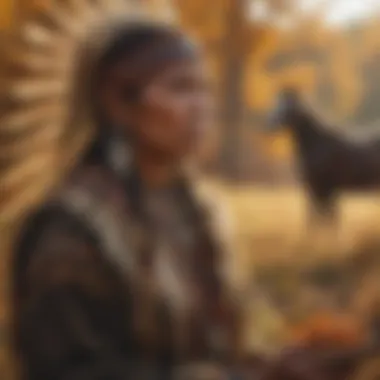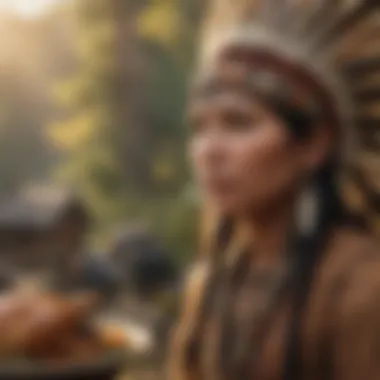Understanding Thanksgiving from Native American Perspectives


Nature Topic Overview
Thanksgiving isn't just a simple holiday celebrated with turkey and pumpkin pie. It has deep roots that intertwine the history of Native Americans and early settlers. Understanding what Thanksgiving means to Native American communities opens up a whole new world of insight into the values and customs that these cultures hold dear. This article will explore how Indigenous peoples perceive this holiday, discussing everything from history to modern celebrations and the ongoing impacts of this event.
Cultural Significance
For many Native Americans, Thanksgiving can be a bittersweet reminder of a history filled with struggles and achievements. Often, communities come together to give thanks— but not in the same context as mainstream celebrations. The essence of gratitude from a Native perspective involves acknowledging the land, the people, and the traditions that have been passed down for generations. These cultural practices can vary from tribe to tribe, but the core values of appreciation often remain the same.
Historical Context
The traditional story of Thanksgiving revolves around the Pilgrims and the Wampanoag tribe. While this narrative is often simplified in educational materials, the real story is more nuanced. Wampanoag people helped the Pilgrims survive, offering vital support in weathering harsh conditions. However, the years that followed were filled with conflict and colonization— events that forever altered Native American communities. By understanding these historical ties, we can see why some Indigenous people reflect on Thanksgiving with a mix of respect and sorrow.
"To many Native Americans, Thanksgiving marks a turning point, a moment to reflect on what was lost and what can still be cherished."
Fun Facts and Trivia
Engaging children with fun tidbits can peak their curiosity. Here are a few interesting facts related to Thanksgiving from a Native American perspective:
- Did you know that the Wampanoag tribe's name means "People of the First Light"? This reflects their deep relationship with the land and the seasons.
- The practice of giving thanks was already a part of many Native cultures long before the arrival of Europeans. They held gatherings to celebrate the harvest and honor the earth’s gifts.
- Many Native Americans still gather each year for ceremonies that reflect their cultures, talking about history and sharing stories.
Visuals and Interactive Elements
Using visuals or interactive elements can enhance the learning experience. Encourage children to draw their interpretation of a harvest celebration or to share stories about what they are thankful for.
DIY Nature Activities
To deepen understanding, kids can engage in hands-on activities that reflect Native traditions or gratitude practices. Here are some suggestions:
- Gratitude Tree: Create a tree art project where children can add leaves with things they are thankful for written on them.
- Harvest Mandala: Using natural items like leaves, pebbles, or flowers, kids can create colorful mandalas to represent the seasons and the cycles of nature.
- Outdoor Exploration: Encourage families to take walks in nature and talk about how Native Americans might have lived off the land, gathering food and celebrating the beauty around them.
Completing these activities not only makes learning fun, but also fosters appreciation for the cultures that have shaped the history of Thanksgiving in America.
Foreword to Native American Perspectives
To fully grasp the essence of Thanksgiving, one must step beyond the familiar narratives and explore the complex tapestry woven by Native American perspectives. This examination reveals not only a cherishing of community and harvest but also illuminates the historical realities of indigenous peoples whose voices often get overshadowed in mainstream discussions.
The Importance of Diverse Narratives
When we talk about Thanksgiving, we often hear about turkey, stuffing, and family gatherings. However, amidst these traditions lie stories that are rich, varied, and often painful. Recognizing diverse narratives enables us to appreciate how different cultures interpret similar themes of gratitude and togetherness.
- Multifaceted Storytelling: By listening to indigenous voices, we uncover the broader spectrum of human experience, enriching our own understanding of gratitude.
- Empathy and Connection: Diverse perspectives foster empathy, allowing us to connect with others on a deeper level. When we adopt multiple viewpoints, we grow more equipped to build bridges rather than walls.
This re-examination doesn’t only serve those interested in history; it invites everyone to engage in meaningful discussions about identity, belonging, and collective memory. As we learn and share these stories, we transform how thanksgiving is perceived and celebrated.
Historical Context of Thanksgiving
The historical backdrop of Thanksgiving carries weight. Most schoolchildren hear about the first Thanksgiving as a cheerful gathering between Native Americans and Pilgrims, often missing critical elements embedded within the narrative. The truth is layered and complex, encompassing encounters full of misunderstandings and consequences that resonate today.
- Pilgrim Arrival: In 1620, the arrival of the Pilgrims marked the beginning of significant changes for Native peoples. Rather than a simple feast, this period initiated an era of colonization that disrupted lives and cultures.
- Indigenous Resilience: Contrary to popular belief, many Native groups have thrived despite colonization. They maintain rich cultural practices rooted in gratitude, but these are often overlooked or misrepresented.
"The history surrounding Thanksgiving is like an iceberg; much lies beneath the surface, waiting to be explored.”


Understanding this historical context invites vital discussions about the impact of colonization, the resilience of Native cultures, and the promise of a more inclusive Thanksgiving celebration that honors all narratives.
Cultural Significance of Harvest Celebrations
Harvest celebrations hold an integral place within Native American culture, serving as pivotal events that embody both historical and contemporary significance. At their core, these celebrations are not just about gathering crops but represent a profound connection to land, community, and the cycle of life. They encapsulate a deep sense of gratitude and respect for nature's sustenance, reminding communities of their roots and heritage. This section delves into the indigenous traditions associated with these gatherings and the broad variations seen across different regions, underscoring the rich diversity and shared humanity found in these practices.
Indigenous Traditions of Gratitude
Ceremonial Gatherings
Ceremonial gatherings are a hallmark of indigenous harvest celebrations. They signify more than just the act of thanksgiving; they are richly symbolic events that foster community bonding while honoring both the land and the spirits of ancestors. These events often include traditional songs, dances, and storytelling moments, each woven together to create a tapestry of cultural expression. A key characteristic of these gatherings is their ability to unite families and clans, allowing them to share their collective stories and wisdom across generations.
One unique feature of ceremonial gatherings is the communal sharing of food, which emphasizes cooperation and unity, as everyone contributes. This communal aspect deepens the bonds among participants and creates a shared sense of purpose. However, it can sometimes pose challenges, such as the need for extensive planning to ensure everyone plays an active role.
Ceremonies serve as powerful tools for instilling identity and belonging in indigenous peoples, helping to reconnect with their history and traditions.
Seasonal Harvest Practices
Seasonal harvest practices are another critical element of indigenous culture that translates gratitude into tangible actions. These involve not only the gathering of crops but also the rituals that accompany them. Many tribes observe specific practices aligned with lunar cycles or seasonal changes, showing their deep understanding of ecological patterns. A distinctive feature of these practices is that they often involve various plant and animal species that are culturally significant, highlighting the balance between nature and the harvesting process.
What sets seasonal harvest practices apart is their emphasis on sustainability. Indigenous peoples often harvest only what they need while leaving enough for future growth, showing respect for the earth. Although beneficial, some might find it a challenge to maintain such practices in modern contexts, where over-commercialization can overshadow these deep-rooted traditions. Nonetheless, returning to these practices fosters a profound appreciation for nature and nurtures a sense of responsibility toward the environment.
Comparative Analysis of Celebrations
Regional Variations
Regional variations in harvest celebrations are reflective of the unique environments and cultures within Native American tribes. For instance, the Makah tribe in the Pacific Northwest holds celebrations centered around salmon runs, whereas the Navajo Nation incorporates corn in their harvest rituals. Such specific practices highlight how geography influences cultural traditions. The key characteristic of these variations is that they allow each tribe to express gratitude for what the land provides in their own unique way, celebrating their cultural identity.
Despite the benefits of showcasing diverse traditions, there can be challenges. For example, understanding and appreciating the different meanings can often get lost in translation. It is essential to approach these celebrations with an open mind and heart, fostering respect and acknowledgment of each tribe's unique practices.
Spiritual Connections to Nature
Finally, spiritual connections to nature form a cornerstone of harvest celebrations across Native American cultures. Many tribal beliefs hold that humans are intrinsically linked to the earth, and harvesting is seen as a sacred act that requires respect and appreciation. The spiritual characteristic of these connections manifests in various rituals that express gratitude to the spirits of nature, ensuring a harmonious relationship. This approach instills a sense of responsibility toward the ecosystem and emphasizes the importance of caring for one's environment.
One unique aspect of these spiritual connections is the embedded teachings that guide harvesting practices. These teachings often convey lessons about balance, respect, and reciprocity with nature, essential for sustainable living. Nevertheless, the modern world often challenges these teachings, as many individuals may not experience or understand these connections. Yet, striving to maintain these values is beneficial for both indigenous communities and broader society, fostering a greater appreciation for nature's gifts.
Histories of Conflict and Coexistence
When exploring the Thanksgiving narrative, it is crucial to consider the Histories of Conflict and Coexistence. This section sheds light on how relationships between Native peoples and European colonizers shaped the histories that many Americans celebrate today. By juxtaposing these notions of conflict and coexistence, we can recognize the complex realities that characterize the interactions between different cultures. Understanding these historical contexts allows for a more nuanced appreciation of present-day discussions around Thanksgiving. It is not just about a feast; it’s about recognizing the multi-faceted legacies that influence both Indigenous and non-Indigenous perspectives.
Early Interactions Between Natives and Colonizers
The early days of European settlement were filled with a mix of curiosity and trepidation. When colonizers arrived on the shores of what is now North America, they encountered diverse and richly-cultured Native American societies. These interactions varied widely, from peaceful exchanges to violent confrontations.
For instance, the infamous encounter between the Wampanoag tribe and the Pilgrims in 1620 marks a pivotal moment. The Wampanoags played a critical role in the survival of the settlers, sharing their knowledge of agriculture and local resources. However, this initial cooperation didn't last long. Colonizers brought diseases that devastated Indigenous populations, leading to a significant power imbalance. As time went by, land disputes and differing worldviews caused rifts between the two groups.
It’s essential to view these early interactions through a lens of complexity, where moments of goodwill coexisted alongside exploitation and misunderstanding. The relationships formed during this period laid the groundwork for subsequent generations' interactions, often fracturing Indigenous communities and altering their ways of life.
Misunderstandings and Misrepresentation
Misunderstandings have often fueled the friction between Native Americans and settlers. Language barriers, cultural differences, and varying beliefs about land ownership led to significant confusion. For example, many Native Americans believed land was a shared resource, vital to sustaining community life, whereas European settlers entered with concepts of private ownership.


Additionally, the representation of Native Americans in stories about Thanksgiving and in broader American culture is frequently misleading. Many historical accounts gloss over or simplify the complexities of Native societies and their profound connections to the land. This misrepresentation can lead to stereotypes that overlook the richness of Indigenous cultures.
"It's not just a feast—it's a moment to reflect on a long history of interactions, sometimes friendly but often fraught with difficulty."
In educational settings, incorporating these critical perspectives can foster greater empathy and understanding. It’s vital to engage younger generations in discussions about the past, emphasizing that history is not simply black and white but a tapestry of intertwining stories that deserve to be told accurately.
Through these explorations of conflict and coexistence, we can start to piece together a broader understanding of Thanksgiving, one that honors Native American experiences rather than relegating them to the margins of history.
Modern Perspectives on Thanksgiving
The topic of Modern Perspectives on Thanksgiving serves as a crucial component in understanding how Thanksgiving is perceived today, especially through the lens of Native American communities. It isn’t just a matter of observing a holiday; it’s about acknowledging its past, its meanings, and its evolving narratives in the present. As society grapples with truths about its history, examining contemporary views can often lead to more inclusive conversations around Thanksgiving.
It offers insights into the resilience of Native communities and their ability to inspire dialogue about recognition, respect, and justice. By portraying modern narratives, we not only honor Indigenous history, but also help dispel myths that have been prevalent over generations.
Contemporary Native Voices
Reflections from Current Leaders
Reflections from Current Leaders in Native communities can bring a wealth of experience and perspectives to the conversation around Thanksgiving. These leaders often emphasize that while gratitude is vital, they do not forget the painful history intertwined with the holiday. This aspect is crucial because it helps highlight the duality of the celebratory and memorial elements that exist side by side in Indigenous cultures.
A key characteristic of these reflections is authenticity. Current leaders are not just voicing what they were taught; they are expressing lived experiences and the realities their communities face today. This makes it a beneficial choice for the article, as it showcases not only historical accounts but also the ongoing impact of those events.
Their unique feature is open dialogue. Many leaders invite those outside of Native communities to engage in conversations that encourage healthy discussion about Thanksgiving’s complexities and its affects. This honest exchange can be advantageous in fostering mutual understanding but can also lead to discomfort for those confronted with uncomfortable truths.
Community Narratives
Community Narratives are another vital aspect of Modern Perspectives. They encompass a rich tapestry of stories shared by individuals within Native communities, each bringing forth their own interpretations and feelings about Thanksgiving. These narratives often reflect a blend of tradition, modernity, and individual experiences, providing a comprehensive view on the subject.
A key characteristic of these narratives is their diversity. Different tribes and families celebrate and perceive Thanksgiving differently, and these varying perspectives enrich the overall narrative. This aspect is particularly beneficial for the article as it reflects the rich mosaic that is Native culture, thus avoiding a monolithic view.
A unique feature is their storytelling tradition. These narratives often weave together personal stories with cultural teachings, preserving history and promoting understanding. For children and families, this way of sharing is both engaging and educational. However, the challenge lies in ensuring that each narrative is recognized and not overshadowed by more dominant narratives about Thanksgiving.
Critiques of the American Thanksgiving Narrative
Critiques of the American Thanksgiving Narrative hold substantial weight in discussions surrounding the holiday. Many Native voices argue that the traditional story often presented tends to romanticize the relationship between indigenous peoples and European settlers, glossing over the harsh realities of colonization.
Some of the key critiques include:
- The notion that Thanksgiving was simply a day of harmony overlooks the conflicts and injustices faced by Native peoples.
- The simplification of complex histories reduces the struggles and resilience of Indigenous communities to mere footnotes in a broader narrative.
Understanding these critiques allows for a more balanced appreciation and understanding of Thanksgiving today. It serves as a call to approach the holiday with a mindset of reflection and learning, ensuring we all acknowledge the full breadth of its implications.
"To think of Thanksgiving only as a celebration is to disregard the history of loss and resilience that is as much a part of the story."
By engaging with these ideas, we encourage meaningful conversations that can reshape our understanding of Thanksgiving into something more inclusive and educational.
Education and Awareness
The topic of education and awareness holds enormous weight when it comes to understanding Thanksgiving through Native American perspectives. It's not just about making folks aware of the diverse narratives; it’s about cultivating a sense of respect for indigenous cultures and histories. Education serves as a bridge, linking the past to the present, revealing the cultural richness and the pain stemming from historical events. Awareness helps to dismantle stereotypes and encourages meaningful dialogue among different communities. The more we know, the better we understand each other.
\


Incorporating Native Perspectives in Education
Curricular Innovations
Curricular innovations that include Native perspectives contribute significantly to achieving a more inclusive environment in education. One key characteristic of these innovations is their emphasis on integrative teaching methods that blend traditional subjects with indigenous knowledge systems. This can mean incorporating local ecosystems, storytelling traditions, and cultural practices into subjects like science or history. The unique feature of these approaches is their ability to engage students with both historical facts and contemporary issues facing Native communities, showcasing a more holistic view of the world.
However, while the implementation of such curricula is a positive shift, it is not without its challenges. Some educators may be hesitant or lack adequate training to incorporate these elements effectively. This makes supporting teachers and providing them with the right tools essential for the success of curricular innovations.
\
Engaging Storytelling Techniques
Engaging storytelling techniques act as a powerful tool in weaving Native perspectives into educational settings. The key characteristic of these methods is the emotional and cultural connection they create between the narrator and the audience. This approach allows students to immerse themselves in stories that resonate on a personal level, fostering empathy and understanding.
One unique feature is the use of oral histories and personal anecdotes, which can bring historical events to life in a way that textbooks simply cannot. It’s like exchanging the dry facts of history for a vibrant tapestry of narratives that celebrate the resilience and diversity of Native cultures.
While storytelling can be incredibly engaging, the potential downside is that not every story resonates with all audiences. Some may find it difficult to relate to certain aspects, especially if they are vastly different from their own experiences. Thus, it’s important to offer a variety of perspectives and styles to draw in a wider range of students.
\
Resources for Further Learning
Books by Indigenous Authors
Books by Indigenous authors can serve as potent vehicles for elevating Native voices and perspectives in literature. A key characteristic of these books is their authentic representation of cultural experiences and histories, often written from the viewpoint of those who have lived the stories. This authenticity is why these selections can be a beneficial inclusion in educational materials, allowing students to hear firsthand accounts that challenge the dominant narratives.
A significant unique feature of works by Indigenous authors is the way they tie traditional knowledge with contemporary issues, making them relevant to today’s readers. This offers both advantages, like fostering a deeper understanding of Native experiences, and disadvantages, such as a potential lack of accessibility for younger readers who may not be familiar with complex themes in some texts.
\
Documentaries and Films
Documentaries and films serve as visual storytelling forms that can greatly enhance understanding of Native American perspectives. The key characteristic of these visual media is their ability to present real-life accounts, interviews, and cultural rituals in an engaging format. This makes them a popular choice for many educators who want to spark interest in their lesson plans.
One unique feature of documentaries and films is the blending of historical footage with present-day narratives, challenging viewers to see the continuity of Native struggles and triumphs throughout history. However, it’s crucial to ensure these portrayals are accurate and respectful, as misrepresentation can undermine the very goal of raising awareness.
"Through education and awareness, we replace ignorance with understanding, discomfort with empathy."
Ultimately, the integration of diverse narratives regarding Thanksgiving in education creates a multi-dimensional understanding that is both informative and transformative.
Finale: A Call for Reflection
In the end, examining Thanksgiving through Native American viewpoints gives us a chance to rethink how we celebrate and understand this holiday. This article hasn't just shown us different traditions but has also invited us to reflect on our own understandings of gratitude, community, and history.
Understanding Through Empathy
To truly grasp the significance of Thanksgiving from an Indigenous perspective, we must foster empathy. This means stepping into the shoes of Native peoples, listening to their stories, and recognizing the pain intertwined with this holiday.
- Listen Actively: Stories often speak louder than facts. By engaging with Native voices, whether through books, documentaries, or community events, we can begin to see the holiday in a new light.
- Cultural Sensitivity: Understanding the cultural practices that honor the land and ancestors can help us appreciate the depth behind gathering and giving thanks.
- Acknowledge Historical Context: Recognizing the complexities of the past helps us to go beyond a surface-level comprehension of Thanksgiving. This isn’t just about a feast; it’s about acknowledging a relationship that has evolved over centuries.
"True understanding comes from listening, not just hearing what we want to hear."
The Future of Thanksgiving Narratives
Looking ahead, the narratives surrounding Thanksgiving can transform.
- Educational Reform: Schools can play a crucial role by including Native American history in curriculums. This small change can create more awareness among young minds, ensuring they grow up informed and respectful.
- Community Celebrations: New forms of celebrations can emerge that honor both the joy of gathering and the complexities of history. Communities might blend traditional foods with stories that represent the Indigenous experience, teaching all attendees more about Native cultures.
- Media Representation: There’s a pressing need for more inclusive media portrayals of Native communities. Films, books, and online content should reflect diverse Indigenous experiences, shifting narratives away from one-size-fits-all approaches.







